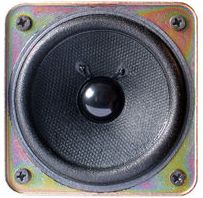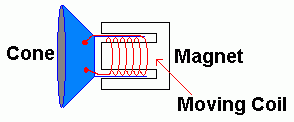
| GCSE Transducer Battery Bulb Buzzer Driver >Loudspeaker< Microphone Motor Neon Piezoelectric Sounder Servo Seven Segment Solenoid |
Transducer Loudspeaker |
|
Input: An alternating electric current.
Output: Pressure waves in air. These are sound waves.

Speakers have a moving coil suspended in a strong magnetic field. When alternating currents flow in the speaker's moving coil, forces are produced which cause the paper cone to vibrate in step with the alternating currents. The paper cone movements cause the surrounding air to move and sound waves are produced.
This diagram shows the structure of a speaker. Its structure is identical to a moving coil microphone but the speaker is much bigger and able to handle large currents to make loud sounds.

Loudspeakers emit sound when an alternating current passes through them. The air pressure waves produced by the speaker are proportional to the current flowing through the speaker.
Loudspeakers are ...
The "empty boxes" delay and channel the energy from behind the speakers, almost doubling the bass output towards the audience.
Subject Name Level Topic Name Question Heading First Name Last Name Class ID User ID
|
Q: qNum of last_q Q ID: Question ID Score: num correct/num attempts Date Done
|
Question Text
image url
Help Link
Add Delete Clone Edit Hardness
Contact, Copyright, Cookies and Legalities: C Neil Bauers - reviseOmatic V4 - © 2016/17
Hosted at linode.com - London
Please report website problems to Neil